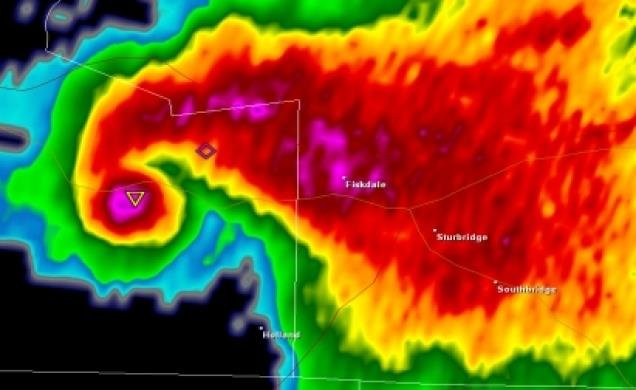-
Posts
70,972 -
Joined
-
Last visited
Content Type
Profiles
Blogs
Forums
American Weather
Media Demo
Store
Gallery
Everything posted by weatherwiz
-

Wednesday, October 7, 2020 Convective Potential
weatherwiz replied to weatherwiz's topic in New England
I think we will have just enough instability, combined with rather cold temperatures aloft to get some lightning with this activity. -
yeah that's a pretty significant increase in lightning over the past half hour or so...certainly looks as impressive as previous bursts.
-

Wednesday, October 7, 2020 Convective Potential
weatherwiz replied to weatherwiz's topic in New England
can't rule out some rotation -
delicious model...some of it's members include Lays; Ruffles, Doritos
- 833 replies
-
- 22
-

-

-

-

Wednesday, October 7, 2020 Convective Potential
weatherwiz replied to weatherwiz's topic in New England
Thinking this looks pretty good across western MA. Could see some gusts 60-65 mph as a broken line moves through. Pretty strong signal for winds. -
Pretty scary that we're continuing to see model intensity guidance bump in the stronger direction. I agree with @WxWatcher007 too...not very sold on the rapid weakening prior to LF.
-
A vigorous s/w trough with attendant cold front is expected to sweep across New England Wednesday. Ahead of this feature, surface temperatures should warm into the 60's to even lower 70's. While dewpoints will be modest (generally in the 50's) sufficient moisture should be available as evident by PWAT values ranging between 0.80'' - 1.00''. A pocket of unseasonably cold air aloft in the mid-levels moving through will result in a plume of steep lapse rates passing overhead. This, combined with surface temperatures into the 60's to lower 70's with modest dewpoints should result in MLCAPE values on order of 250-500 J/KG. This feature will also be associated with rather strong wind shear, characterized by a 500mb jet max of 100+ knots with a low-level jet of 30-40+ knots. This will result in sufficient shear to assist with storm formation and storm organization. Multiple short-line segments are likely to develop Wednesday afternoon as this feature propagates across New England. Combination of strong shear aloft, steep lapse rates, inverted-V profiles, and potential for strong mixing will result in the potential for damaging wind gusts. If stronger convection can materialize, small hail would become a possibility. The greatest potential is from north-central NY through central New England where the best overlap of ingredients look to exist.
-

Tuesday, September 29, 2020 Low Cape/High Shear Convective Setup
weatherwiz replied to weatherwiz's topic in New England
That was not a bad looking low topped line this morning. damage!!! -

Tuesday, September 29, 2020 Low Cape/High Shear Convective Setup
weatherwiz replied to weatherwiz's topic in New England
Still looks game...actually even better for a low topped squall line tomorrow night. Might even see a little surge of elevated CAPE ahead of it. Wouldn't be surprised to see the marginal risk expanded north. -

Tuesday, September 29, 2020 Low Cape/High Shear Convective Setup
weatherwiz replied to weatherwiz's topic in New England
Read last post. The timing has slowed down quite a bit. Looks like this whole thing becomes much more amplified than what it looked at the time. -
Well too be fair, most people are too thanks to the COVID
-

Tuesday, September 29, 2020 Low Cape/High Shear Convective Setup
weatherwiz replied to weatherwiz's topic in New England
Might actually be more Tuesday than Monday but still looks like we could see some sort of line...though probably more low topped. -
What sucks is you can't alter the base climo period on this page. https://psl.noaa.gov/cgi-bin/data/composites/printpage.pl If you could do that...ughhh I think you could certainly be able to spot short and long term trends. I suppose though those who are Python experts could probably do something but that is certainly not me.
-
Thank you! These are my thoughts exactly. I was thinking of using the 1951-2010 option to go about this. This is something that came to me a few years ago. It's actually kinda fun to take a season and then compare it to all the different climo periods. You can actually see a definite shift and in some cases it's pretty striking.
-
I'm curious for your input (and anyone else who wants to contribute) on something. I've been wanting to get back into some research side of things and one of those things is regarding ENSO. When using the ESRL pages to draw up composites one thing I've been heavily weighing is the climo period being used. Often times, when you see composites thrown around (let's say a much older period) they are being compared to the most recent climo period (in this case 1980-2010). Would you agree, the best course of action to take is to use a base period which is closer to that time you're assessing? For example, Let's say you wanted to see DJF temperature anomalies for the La Nina winter of 1949-1950...would you really want to be using 1981-2010 climo? or would it be much more accurate to compare to a climo period closer to the specific period? I guess at the end of the day the differences shouldn't be large, but I would think it could certainly skew things a bit.
-
Well...welcome to fall. A season where low topped convective setups become more typical as strong cold front move into airmasses with marginal instability. Computer forecast models have been rather consistent in a pretty significant shortwave trough approaching the region and then de-amplifying a bit as it approaches with the trough sort of lifting out. While usually this is an indication of a weakening system, wind fields aloft are quite strong. At the surface, we'll have an unseasonably warm and moist airmass with temperatures into the 70's and dewpoints into the 60's. Poor mid-level lapse rates will limit instability potential, however, several hundred J/KG of CAPE would be likely. The combination of strong shear/forcing and marginal instability will likely promote the development of one or multiple line segments which will be capable of producing localized damaging wind gusts. Convection may be low-topped but this is dependent on how much instability materializes.
-
Forgive me if I have misunderstood your post and the jest of what you were saying but from what I gather, you essentially also believe the ENSO-atmospheric response/interaction doesn't hold as much weight as we once thought or as they once did...is that correct? If I did interpret that correctly, I also agree...and strongly. I know ENSO was/still is an "essential tool" behind seasonal forecasting but I fully believe ENSO just isn't that big of a driver...it just seems like there are so many other variables that, when combined, hold more weight than ENSO. Now...is this due to climate change or is it perhaps due to an incorrect understanding we had on ENSO? The later could be very true...especially as the data set regarding different ENSO events expands, the different strengths, and even the structure of the anomalies themselves. But...if the oceans overall are becoming warmer and we constantly see the majority of ocean temperatures being warmer than average...this I'm sure will hold a significant amount of weight and influence teleconnections and how they dictate global weather patterns...regardless of ENSO state.
-
Has NOAA been hacked or something? They've seem to be having some extensive problems or the better part of the last several months...server issues, product issues, older data/graphics being displayed, model issues. It's been pretty bad.
-
I'm really beginning to despise social media. I certainly see the good in it, however, I question whether the good outweighs the bad. I couldn't agree more regarding the conspiracy theories and fake news. What is also really irritating me are all these memes being floated around with information/statistics and they are shared like it's gospel...it's like if it's on a meme it's gotta be true. Now I totally get some people just share this stuff and don't take it seriously but many do. It's so easy to come up with a meme and throw info on their that supports a stance and for it to then be shared wildly by those who share the same stand. It's also irritating in terms of weather...just so much crap gets posted around. during tropical season...312-HR GFS maps showing a system over NYC...during winter...24-HR TOTAL snowfall maps...for severe...a 96-HR GFS SHARPpy sounding showing PDS Tornado...all this stuff does is generate unecessary hype...it gets into the hands of the wrong people, people get freaked out, and when that scenario doesn't unfold, forecasters are blamed...even though its weenies posting nonsensical trash.
-
You would think we are headed towards a stronger Nina episode based on how everything has transitioned the past few weeks. I kinda hate looking so closely at SSTA's this early and putting a significant amount of thought into them (outside of the Nino region) but it's kinda hard to ignore the striking configuration...but I guess with climate change such a look is just going to become the norm. In the PAC, outside of the ENSO region it's pretty much bath water...especially the NPAC from East Asia to the western North American coast. The PDO has become quite negative as well (perhaps also influencing the rapidly developing Nina?). Obviously the NPAC (more specifically the Gulf of Alaska) is prone to changes and we could see these anomalies cool some as we we into the cool season. But as long as the anomalies remain this impressive you would think this will result in strong latent heat release which could keep ridging established in this region...of course which may not be a bad thing for us. The Atlantic too (especially off the East coast) is extremely warmer than average (thanks in part to the lack of cold fronts and established ridging). Even off the coast of Greenland it's super warm. This could perhaps leads to one of two things; 1) Keeps NATL ridging established well into the winter with ridging extending to the East 2) Enhance the probability for a negative NAO/AO If we are able to establish a ridge into the West hopefully we can be sandwiched between the two ridges...and then it's just a matter of where the trough axis can become established. I think there is quite a bit of potential in this upcoming winter. In terms of ENSO, we should continue to see quite a bit of cooling in the ENSO regions...quite a bit of easterly wind bursts and a pretty significant one forecast too right around the dateline:
-

Significant Severe Weather Event Possible Thursday, August 27, 2020
weatherwiz replied to weatherwiz's topic in New England
Ahh I'm not far from there at all. Looks like it's right off Mill Plain. That's the road I use to/from Branford-North Branford then to 91 in Wallingford. -

Significant Severe Weather Event Possible Thursday, August 27, 2020
weatherwiz replied to weatherwiz's topic in New England
Awesome thanks! I won't be able to today but I will do so on Tuesday! -

Significant Severe Weather Event Possible Thursday, August 27, 2020
weatherwiz replied to weatherwiz's topic in New England
Where about's is that? I actually don't know Branford quite well lol. I basically just know the road from about exit 54 to exit 55. -
I tried to avoid commenting on that
-
This is a fantastic point. Strongly agree with your thoughts. Especially with the "levels"...not only does the general public not understand it but I'm sure those with a meteorological/agricultural background don't either. Same thing with the SPC risk outlooks...general public certainly doesn't understand them (which I guess they aren't meant for the general public) and some meteorologists/forecasters don't understand them and they incorrectly rely the information to the public.

